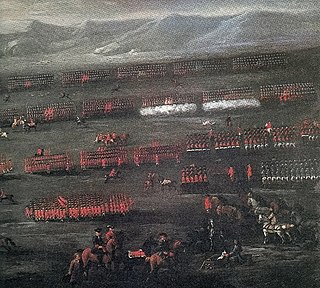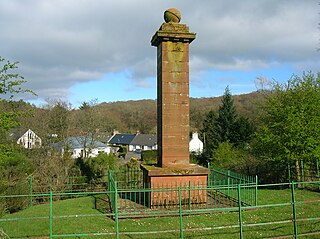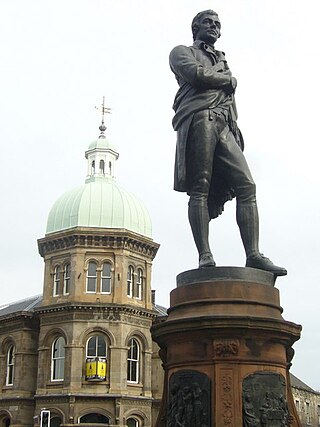
Dunoon is the main town on the Cowal peninsula in the south of Argyll and Bute, Scotland. It is located on the western shore of the upper Firth of Clyde, to the south of the Holy Loch and to the north of Innellan. As well as forming part of the council area of Argyll and Bute, Dunoon also has its own community council. Dunoon was a burgh until 1976.

Cowal is a rugged peninsula in Argyll and Bute, on the west coast of Scotland. It is bounded on the west by Loch Fyne and on the east by Loch Long and the Firth of Clyde. The Kyles of Bute separate it from Bute to the south.

The Battle of Sheriffmuir was an engagement in 1715 at the height of the Jacobite rising in England and Scotland. The battlefield has been included in the Inventory of Historic Battlefields in Scotland and protected by Historic Scotland under the Scottish Historical Environment Policy of 2009. Sheriffmuir is a remote elevated plateau of heathland lying between Stirling and Auchterarder on the north fringe of the Ochil Hills.

Clan Lamont is a Highland Scottish clan. The clan is said to descend from Ánrothán Ua Néill, an Irish prince of the O'Neill dynasty, and through him Niall Noigíallach, High King of Ireland. Clan Ewen of Otter, Clan MacNeil of Barra, Clan Lachlan, and Clan Sweeney are also descendants of Ánrothán. Traditional genealogy would therefore include Clan Lamont among the descendants of Conn Cétchathach.

The Burns Monument in Kay Park, Kilmarnock, Scotland, commemorates the poet Robert Burns (1759–1796). It is located at an elevated position within Kay Park, to the east of Kilmarnock Town Centre. The monument was opened in 1879, and is a category B listed building. In 2004, following years of neglect by the local council, fire destroyed most of the building. What was left of the monument was incorporated into the new Burns Monument Centre which opened in 2009. In 2010 the centre was shortlisted for the Carbuncle Cup award run by Building Design.

Robert Burns, also known familiarly as Rabbie Burns, was a Scottish poet and lyricist. He is widely regarded as the national poet of Scotland and is celebrated worldwide. He is the best known of the poets who have written in the Scots language, although much of his writing is in a "light Scots dialect" of English, accessible to an audience beyond Scotland. He also wrote in standard English, and in these writings his political or civil commentary is often at its bluntest.

The Dunoon massacre was a massacre that took place around Dunoon on the Cowal Peninsula, Scotland, on 3 June 1646. Men of the powerful Clan Campbell massacred men, women and children of the Clan Lamont.

Highland Mary is a song composed in 1792 by Scottish poet Robert Burns. It is one of three works dedicated to Mary Campbell, with whom Burns was in love in the 1780s. The others, "Highland Lassie, O" and "Will Ye Go to the Indies My Mary?", were composed in 1786. "Highland Mary" consists of four stanzas that speak of Burns's affection for the lady, his melancholy at her death and his continued memory of her. The melody was that of "Katherine Ogie."

Dunoon Castle is a ruined castle in Dunoon on the Cowal peninsula, in Argyll and Bute, Scotland. The castle sat upon a cone-shaped hill about 80 feet (24 m) high. Very little remains of the castle's structure today. Castle House, built in 1822, stands a few yards north of the castle ruins.

Mary Campbell, also known as Highland Mary, was the daughter of Archibald Campbell of Daling, a sailor in a revenue cutter, whose wife was Agnes Campbell of Achnamore or Auchamore. Mary was the eldest of a family of four. Robert Burns had an affair with her after he felt that he had been "deserted" by Jean Armour following her move to Paisley in March 1786. The brief affair started in April 1786, and the parting took place on 14 May of that year. Mary's pronunciation of English was heavily accented with the lilt of local indigenous language, Gaelic - and this led to her becoming known as 'Highland Mary.'

Dunoon Primary School is a school in Dunoon, Argyll and Bute, Scotland. It is located in a Category B listed building dating from 1901.

David Watson Stephenson was a Scottish sculptor, executing portraits and monuments in marble and bronze.

Robert Burns is a bronze portrait statue of Robert Burns by John Steell. Four versions exist, in New York City, Dundee (Scotland), London (England), and Dunedin.

William FraserRIBA was a Scottish-born architect, prominent in the late 19th and early 20th centuries, who initially practised in Great Britain and then in Canada until his death in 1922.















